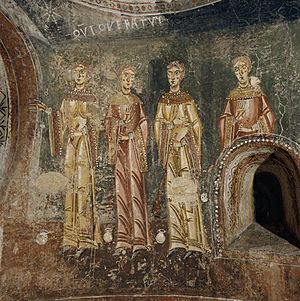Southern apse from Pedret facts for kids
Quick facts for kids Southern apse from Pedret |
|
|---|---|
 |
|
| Artist | Circle of the Master of Pedret |
| Year | End of 11th/beginning of 12th century |
| Type | Fresco transferred to canvas |
| Location | Museu Nacional d'Art de Catalunya, Barcelona |
The Southern apse from Pedret is a very old Romanesque fresco painting. It was made around the late 1000s or early 1100s. This painting was bought by the Junta de Museus between 1919 and 1923.
The artwork originally came from the southern part of the Church of Sant Quirze de Pedret. Today, you can see it in the Romanesque Art collection. It is displayed at the Museu Nacional d'Art de Catalunya in Barcelona, Spain.
Contents
History of the Pedret Frescoes
Around the end of the 11th century, a style of Romanesque wall painting from northern Italy became popular. This style spread to Catalonia, a region in Spain. Italian painters brought their techniques, which had a big impact on local art.
A great example of this Italian-influenced painting is the art from Sant Quirze de Pedret. Its style is similar to paintings found in other churches. These include Sant Pere in Àger, Santa Maria in Àneu, and Sant Pere in El Burgal. It also resembles art in Saint-Lizier in Couserans in France.
The Church of Sant Quirze de Pedret
The church at Pedret is located in the Pyrenees mountains. Even though there are no written records of its worshippers, it was likely very important. This is because it was on main roads connecting towns like Berga, Bagà, and Cerdanya.
Experts believe the church's first design was Visigothic. This is due to special features like its horseshoe-shaped arches. These arches divide the main area and lead into the rounded sections called apses. The way the apses are separated also points to this style. Some also describe the architecture as Mozarabic.
Dating the Pedret Paintings
Many ideas exist about when the frescoes were painted. These ideas consider art styles from the 900s to the 1100s. They also look at changes made to the church during those times. The museum where the frescoes are now displayed dates them to the late 11th or early 12th century.
Because of their age, the Southern apse from Pedret paintings are likely among the oldest Catalan Romanesque wall paintings.
Where to See the Pedret Art
The National Art Museum of Catalonia holds the two side apses from Sant Quirze de Pedret. The Museu Diocesà i Comarcal in Solsona has the paintings from the central apse. Together, these artworks show an important series about the end of the world.
They uniquely connect the idea of the Church with the Day of Judgment. The southern apse, in particular, focuses on the story of the wise and foolish Virgins.
What the Painting Shows
The apse painting is about 325 cm tall, 315 cm wide, and 320 cm deep. It shows several images. The most important part is a damaged picture of the parable of the Wise and Foolish Virgins. This story comes from the Bible, Matthew 25:1-13.
The Wise and Foolish Virgins
Three of the five Wise Virgins' heads are missing. This happened because of old building work on the church. All the figures seem to wear similar fancy robes called dalmatics and tunics. Their sleeves are close-fitting under the open sleeves of the dalmatics.
The Wise Virgins wear bridal crowns on their caps and spiral earrings. These crowns look like ones from Rome in the 500s. Originally, all five Wise Virgins were shown sitting at a wedding feast. They held burning lamps in their left hands. The figure of the Bridegroom (Christ) is mostly gone, but his hand can be seen over the table.
On the other side of the scene are the five Foolish Virgins. They do not wear the fancy dalmatics or crowns like the Wise Virgins. Instead, they have simple caps arranged in folds over their hair. Unlike the Wise Virgins, the five Foolish Virgins hold their lamps upside down. Small oil containers hang from their lamps.
Other Details in the Apse
Below the virgins, there is a pattern of "medallions of beasts." This means round shapes with animal figures inside them. A young figure is also shown sitting on a church. This figure has a halo around its head.
It's not clear if the figure is male or female. Also, what they hold in their hand is debated. Some think it's a wand, a lily, or a palm branch. What everyone agrees on is that this image represents the Church itself.
Traces of the Archangel Gabriel and the Virgin Mary were once seen, but they have completely faded. However, the letters SCA MARIA (meaning Saint Mary) were recorded. A picture of the Theotokos (Mary holding baby Jesus) was also there. But it was covered with plaster during repairs.
Below the main figures, there is a pattern called a fret. There are also painted designs that look like draped fabric. The apse's window is also decorated with a geometric pattern.
How the Painting Was Made
This painting was originally a fresco. This means it was painted directly onto wet plaster on a wall. Later, it was carefully removed from the wall and moved onto a canvas. This technique is called "fresco transferred to canvas."
The artwork is believed to be made by artists from the Circle of the Master of Pedret. This means it was created by artists who worked in the style of, or were students of, a main artist known as the Master of Pedret.
See also
 In Spanish: Pinturas de Pedret para niños
In Spanish: Pinturas de Pedret para niños

